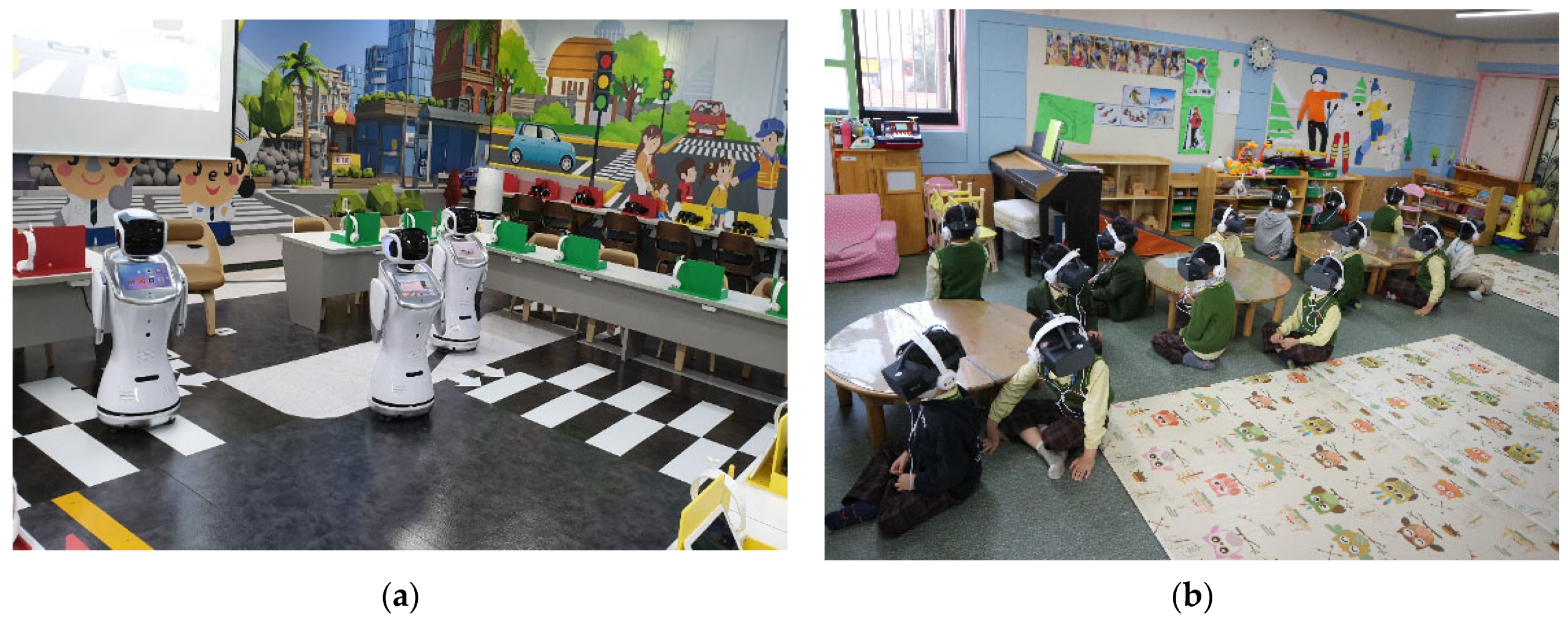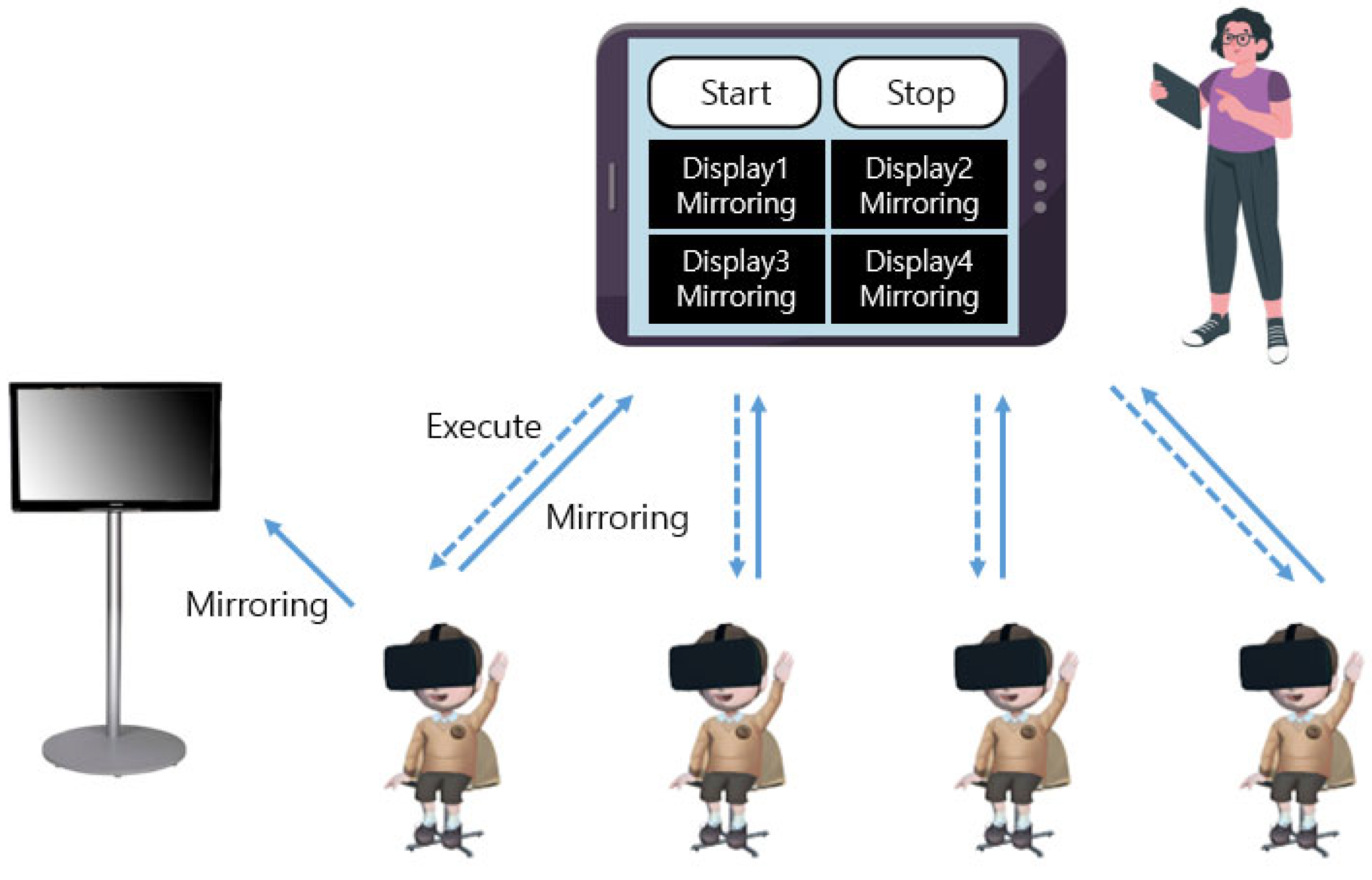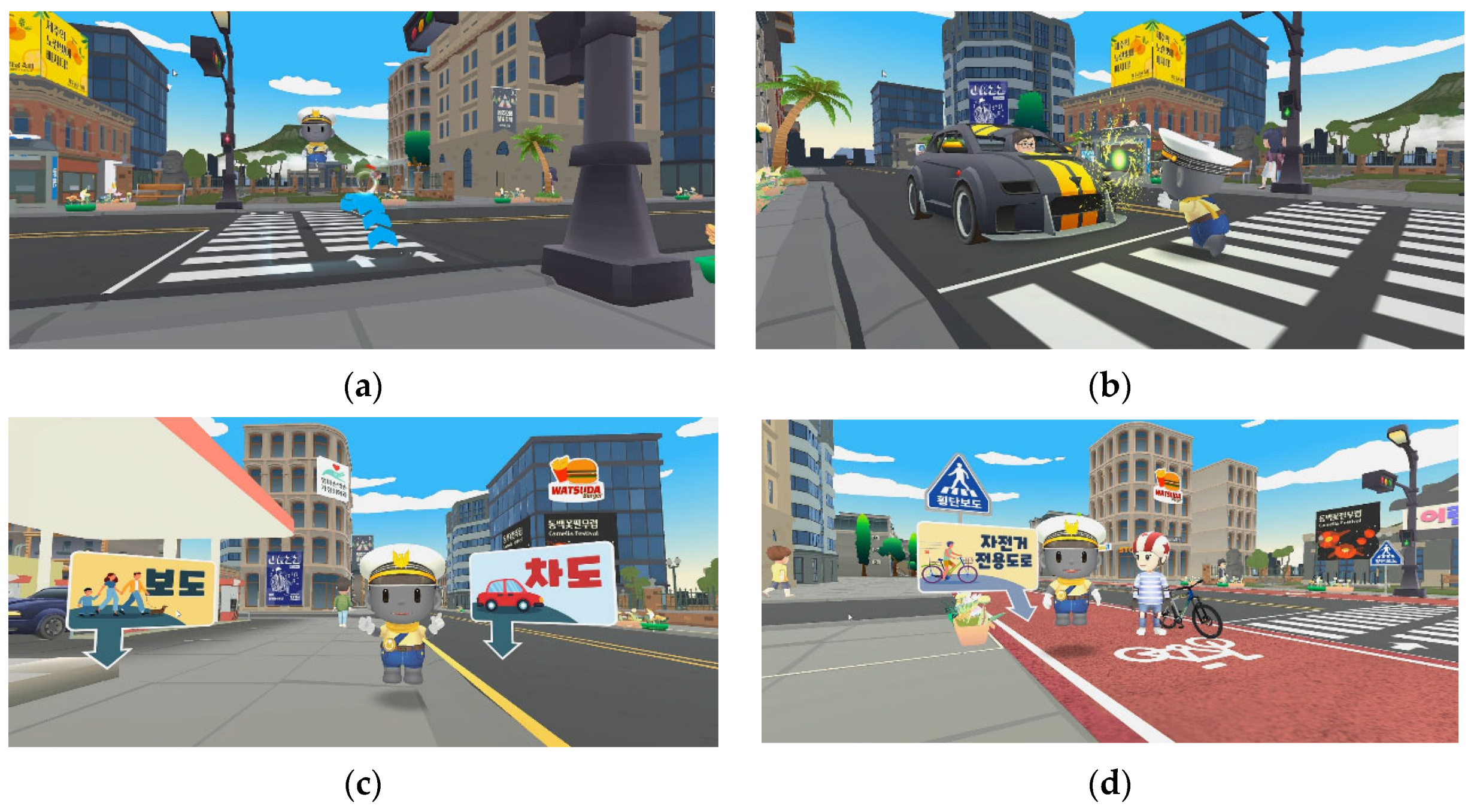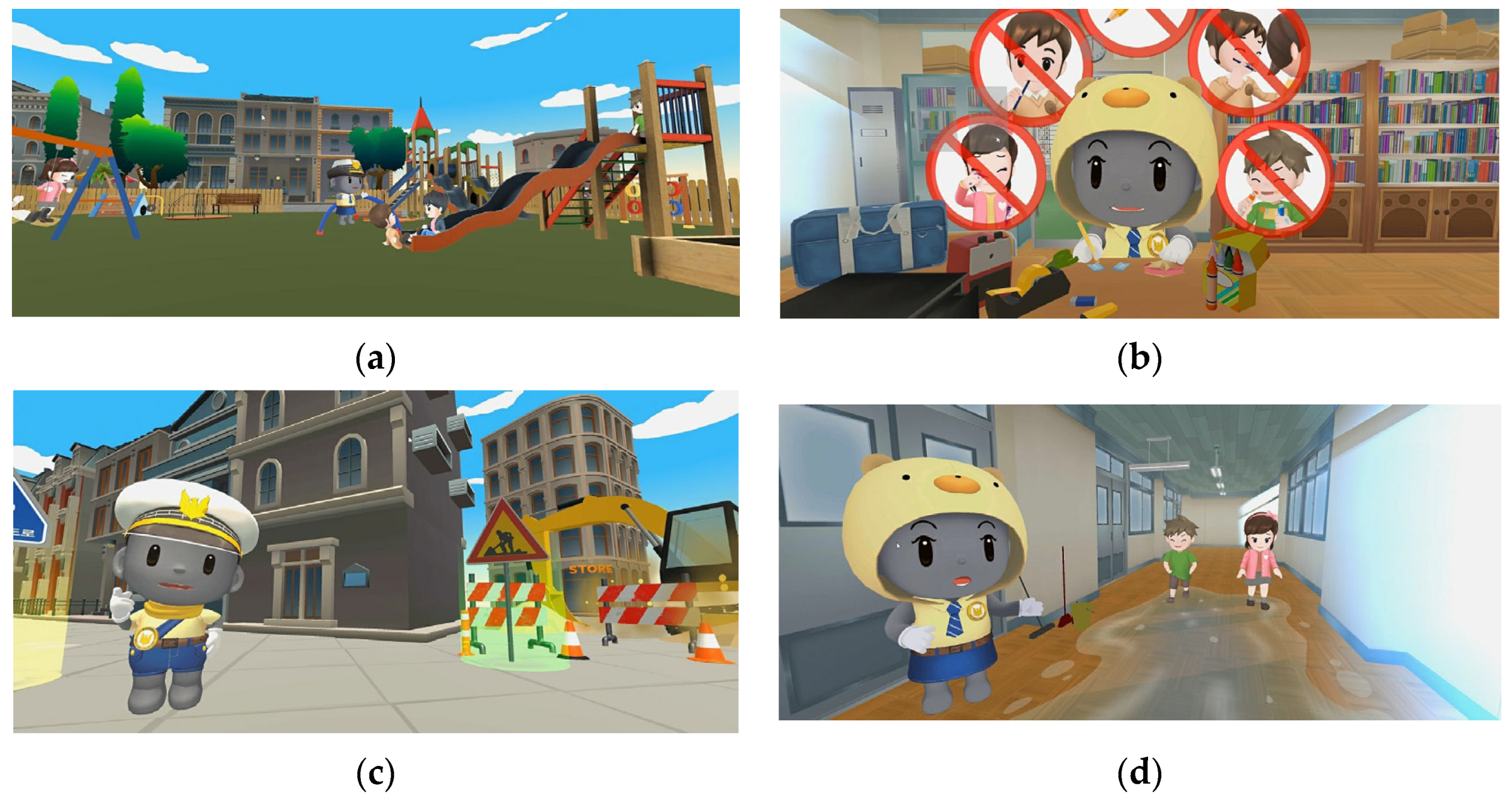1. Introduction
In 2018, 54 child pedestrians were killed in road accidents in South Korea, accounting for 33.1% of 163 children who died in traffic accidents [
1]. Children are the most vulnerable when it comes to traffic safety, particularly in pedestrian accidents. In early childhood, physical functions are underdeveloped and the ability to maintain body balance and motor functions is not sufficiently developed. In addition, infancy exhibits traits that may affect what might happen in dangerous situations [
2].
Infants should develop their ability to cope with safety on their own through safety education because adults cannot always protect them and do not know when a safety accident can occur. The objective of safety education is to induce infants to take safe actions on their own, and to achieve this, infants must be able to recognize risks on their own and develop practical coping skills with accidents [
3].
Safety education for infants should be conducted indoors in early childhood educational institutions [
4]. Infants lack the ability to perceive hazards, and even when recognizing the dangers of accidents, they do not respond appropriately.
Even if the teacher creates a safe environment, the possibility of a safety accident will not decrease unless careful actions are taken [
5]. By establishing the right knowledge and attitudes related to safety from infancy, it should be possible to improve the ability to foresee and respond to risks [
6].
Early childhood education institutions are the most effective and systematic places for safety education for children. The knowledge or attitudes that can be obtained through life safety education at these educational institutions and should include the knowledge or attitudes necessary to live safely, rather than simply supervised or directed, or the attitude to predict and prevent risk factors and act prudently [
7].
Safety education in early childhood education institutions consists of books, video materials, and storytelling, whereas safety education centered on practical training and experience is insufficient [
8]. In the safety education of children, simulation situations or role-play that are most similar to reality are effective [
9]. However, safety experience centers where young children can experience safety education are insufficient or limited in use, and safety education programs and teaching methods are also insufficient.
However, it is difficult to cultivate practical safety skills that can cope with crisis situations through education that unilaterally transmits safety knowledge [
10]. Therefore, safety education for infants should be centered on activities based on actual situations and experiences [
11,
12].
Safety education using games is a method frequently used in early childhood education institutions, which induces the active participation of young children and is an activity that provides goal-oriented and rich learning opportunities through play with rules. In addition, if safety education activities are performed using VR, they can be conducted in early childhood education institutions without going to a separate experience hall.
Infants can experience close to real life using the device and develop a variety of colors through animation effects, and the advantages of simulation or graphic depiction provided by the device can foster imagination and creativity. Infants can learn using a variety of materials through VR devices, so they can feel interested in learning and developing problem-solving skills and have an active learning attitude [
13]. Research has shown that learning using multimedia is relatively efficient and effective in achieving self-learning outcomes [
14,
15].
Virtual reality (VR) enables people to feel immersive through the five senses of the human body and a sense of reality as if they were actually in the space without having to directly experience an environment that is difficult to experience on a daily basis [
16]. VR is a human–computer interface (HCI) technology that uses computer software to create a virtual space similar to the real space and allows the user to interact with objects in the space as if they were real [
17]. Learning through a wide range of educational multimedia, including VR educational media enables learners to interact with it and arouse their curiosity and interest, which promotes self-directed learning.
Since the 2000s, research has been conducted to explore the pedagogical effects of ICT media for infants rather than the controversies over the use of ICT media in education, and therefore, the perception of ICT media has changed positively. The need for a learning method that can utilize content suitable for early childhood development has been raised [
18]. Furthermore, since the late 2000s, with the expansion of ICT media distribution in early childhood education, studies on the development and application of educational programs that use ICT media have been actively conducted. VR can express realistic visual and auditory stimuli, and the artificial world can be perceived as if it were real. With the concept of remote presence, learners exist in a virtual place and can experience it [
19,
20].
Educational media using VR also have the advantage of multimedia. In a multimedia teaching-learning environment, the virtual simulation program helps to increase the learning effect by increasing the learner’s indirect experience, or stimulate the sensory organs such as sight and hearing using graphics, video, sound, etc. The purpose of VR-based experience for safety education content learning effect is to learn how to solve problems so that learners can experience a situation similar to reality. Learners can cope with and use it in a real situation. VR safety education activities are more effective than the existing education. The use of VR has effects such as removing risk factors from the educational field and increasing the sense of cooperation; therefore, the use of VR-based tangible safety education content is increasing.
It is classified into two technologies at the development status of VR technology for early childhood: VR HMD (Head-Mounted Device) and VR contents. VR HMD for early childhood was not developed because marketability was not guaranteed, and most of them were developed for adults. Separate devices for children are not manufactured. Most VR HMD manufacturers’ products include warnings about age restrictions. In Korea, the government’s position on using VR devices for children is ambiguous, so it is not recommended and not activated. The minimum age limit for the Meta Quest Pro, released in October 2022, is 14 years old. Additionally, contents for children’s VR are being developed in all areas of education, and these 3D contents are being introduced and utilized in AR/MR.
The use of smart devices as educational tools is increasing. In other words, using VR programs that can provide pleasure, children are approached through play, and life safety education focuses on experiences. Even group education can be conducted as an individual activity. In South Korea, a VR safety education program for early childhood has recently been developed and applied. However, no research has been conducted on the actual status of teachers’ perceptions of safety education for early childhood and the analysis of the effects of VR safety education. Therefore, through this study, we intend to conduct research on VR safety education programs for early childhood.
It is necessary to expand the scope of safety assurance by implementing education using VR programs so that children can protect themselves from danger and act accordingly. In this study, as a method of safety education for young children, safety education will be implemented using VR based on virtual reality, and the preferred VR safety education method. Unlike textbooks or web-based education, which provide information based on text and images, it provides a more three-dimensional educational environment and has various educational advantages. The purpose of this study was to investigate that the safety education Using VR show a high preference as a teaching method and a high preventive effect, by increasing children’s understanding, based on high immersion in a shorter time and affecting their awareness and attitude towards safety. In addition, it is expected that VR content in the field of early childhood education will become a stepping-stone for the expansion of educational media, for the overall growth of children’s developmental areas. The research questions were:
What is the status of safety education in early childhood education institutions?
Is traffic and life safety education using VR more immersive and more preferable than other tools?
How does traffic and life safety education using VR affect children’s preventive attitude toward safety?
The rest of paper is organized as follows. Firstly, the research method for verifying the effect of children’s VR safety education is explained in
Section 2. After analyzing the research results obtained through the questionnaire in
Section 3, the conclusion is drawn after discussion in
Section 4.
2. Research Methods
2.1. Introduction of Virtual Reality Based Safety Education
This study conducted a VR education program on traffic and life safety for Early Childhood to test the educational effect of the ‘Children’s Traffic Park Virtual Reality (VR) Experience Education [
Figure 1] produced in J-city Children’s Traffic Park in 2020. To improve reliability and validity, a preliminary survey was conducted after verification by 10 experts by modifying and the existing safety education awareness survey and educational effect questionnaire according to the research purpose and used for validation.
As shown in
Figure 2, the tablet controls the start, run, and stop of the safety education VR video used by the children. The screen viewed by the infant mirrored the presenter’s tablets. Training begins when a toddler sitting in a swivel chair looks in the direction of the virtual police. The educational content includes traffic safety and life safety. The presenter pre-trains precautions to not move around, not play around, and not turn the swivel chair. The presenter teaches them to raise their hands if there is a problem.
Life-safety education content using VR includes traffic and life-safety education. The content of the scenario of traffic safety education using VR includes how to cross the street, distinguishing traffic signs, safety rules for using public transport, prevention of car accidents, and scenarios of pedestrian safety. Life safety also includes safety rules for facility use, product safety, facility safety, physical activity safety, and prevention of kidnapping and missing children. As shown in
Figure 3, “How to Cross the Road” shows safe crossing and using a crosswalk, and “Pedestrian Safety” shows how to differentiate between roadways and pedestrians and riding a bicycle. VR content for life safety is shown in
Figure 4.
2.2. Human Research Subject
This study was conducted from September to November 2020 at an early childhood education institution in J City, including 150 children aged 4–5 and their homeroom teachers. A basic survey was conducted with participants. There were 86 (67.2%) children in early childhood education institutions and 42 (32.8%) in daycare centers. The age distribution of the infants was 14 (10.9%) 4-year-olds and 114 (89.1%) 5-year-olds. As for the safety education method implemented by early childhood education institutions, 87 (68.0%) answered audiovisual classes, and it was found that they were used the most, followed by 41 (32.0%) of children participating in classes with normal content. The safety training period was conducted 1–2 times a week for 97 (75.8%) children.
2.3. Research Tool
A research tool was designed to test the educational effect of the ‘Children’s Traffic Park Virtual Reality (VR) Experience Education, produced at the J-City Children’s Traffic Park in 2020. The questionnaires on the sub-factors of the research tool were related to safety awareness, safety management, and VR for children (
Table 1). In this study, the questionnaire includes questions related to traffic safety education, life safety education, and VR as three main factors. Traffic safety education and life safety education questionnaires were modified from the questionnaires used in the research on study on the present status and needs of traffic safety education in early childhood education centers [
21]. In addition, the questionnaire related to VR was modified from the questionnaire used in a study on the introduction of VR education methods for increasing the effectiveness of safety training on-site for adults [
22]. Additionally, the modified questionnaire was refined according to the advice of 10 experts, and the questionnaire was verified through a preliminary questionnaire by 5 other experts. All items are on a 4-point Likert scale of ‘not at all’, ‘disagree’, ‘agree’, and ‘strongly agree’, with higher scores indicating higher ability for safety awareness, to manage safety issues and to immerse safety. The scenario of safety education using VR consists of traffic and life safety education. The first type of traffic safety education is on how to safely cross the road, distinguishing traffic signs, safety rules for using public transportation, and automobiles. It consists of accident prevention and pedestrian safety. The second life safety consists of safety rules for indoor facility use, industrial product safety, multi-use facility safety, play activity safety, and prevention of kidnapping and missing children.
This research tool measures the effect of a VR education program on the transportation and life safety of young children. Among the safety education effect questionnaires using virtual reality, five out of seven questions on immersion and subsequent VR safety education utilization were revised and supplemented through preliminary questionnaires. There are two sub-factors: immersion, pre-safety effects, and the future use of safety education. All items are on a 4-point Likert scale ranging from not at all’, ‘disagree, agree, and ‘strongly agree’.
2.4. Research Method
This study was divided into preliminary and main research. The preliminary survey was conducted for two months, from August to September 2020, with the consent of five experts, to verify the suitability of the terms used in the questions and the content of the questions, and to check the reliability and validity of the research tool. Ambiguous sentences were corrected, and contents judged inappropriate for the subject of the study were corrected and supplemented after the preliminary study. The duration of the questionnaire was 7–10 min.
The main study was conducted for one month, from October to November 2020. In total, 150 copies were distributed, and the recovered 128 copies were analyzed. In this study, after completing safety education using VR, the teacher filled out a questionnaire through storytelling, quizzes, and Q&A sessions with children. The VR safety education program used in this study is ‘Children’s Traffic Park Virtual Reality (VR) Experience Education’, which was produced in J-City Children’s Traffic Park in 2020.
The safety education method using VR was designed to increase motivation and understanding of safety by conducting indoor safety education for VR scenarios of education managers belonging to J-City Children’s Traffic Park before the children experienced VR. Safety training was conducted under the guidance of the person in charge and the training assistant so that the children could experience VR safety education while wearing the HMD.
In this study, the SPSS (for Windows) 18.0 statistical program was used for data analysis. The data analysis according to the research question included frequency analysis, descriptive statistics, t-test, F-test, Pearson’s simple correlation analysis, ANOVA, and multiple regression analysis.
4. Conclusions and Discussion
This study investigated the effects of traffic and life safety education programs using VR on children’s safety perceptions and attitudes. The discussion based on the results obtained in this study is as follows.
First, it was confirmed that the preference for audiovisual classes and VR as effective teaching methods and media in early childhood education institutions is high. This is consistent with the research results, where the use of VR-based tangible safety education content is increasing as the safety education activities of VR are more effective than existing education, and the use of VR has effects such as removing risk factors and increasing the sense of cooperation. In other words, safety education provides an environment for practical experiences, experience-oriented simulation experiences, and training, and learning using multimedia increases children’s interest, allowing them to be immersed and actively engaged. This is in line with previous studies showing that it is relatively effective in learning. Through VR-based experiential safety education contents, learners experience situations similar to reality and learn problem-solving methods through the process of coping and using them in real situations.
Second, VR safety education was positively correlated with children’s traffic and life safety perceptions and attitudes. This is partially consistent with the research results, which claimed that safety education using media had a positive effect on safety problem-solving accidents and safety perception. In other words, through safety education using VR media, children’s awareness and attitudes toward safety can be raised, and the educational effect and utility of safety education through VR can be expected.
Third, among the factors of the safety education effect using VR, immersion was found to be a significant factor influencing safety education perception and attitude.
The factors that influenced the level of immersion in VR safety education were traffic safety perception, life safety perception, life safety attitude, and traffic safety attitude. It was found that the higher the level of immersion, the greater the influence on the perception and attitude toward safety education. This shows that safety education using media in which children can feel interested is effective.
It was found that when safety education is implemented through VR, which utilizes media more realistically, it increases children’s immersion and is stored in long-term memory, which affects children’s perception of safety. In other words, the effectiveness of VR classes has a positive effect on learning compared with existing classes, and the concentration is expected to be higher because learners can immerse themselves in learning.
In other words, classes using VR content allow learners to learn actively, which will raise their interest in the subject of the class. This is also consistent with the results of research showing that it improves learner satisfaction, which helps increase class participation.
The safety education activities for children carried out by maximizing the benefits of VR will provide a simulated experience and stimulate their sensory and auditory senses, which will lead to an increase in their immersion level.
Safety education using VR is necessary for infants to indirectly experience safety accidents in the artificial world, to understand the importance of safety accidents, and to maintain a safe life and cope with safety accidents.
Safety education using VR has the advantage that children can learn about safety on their own while experiencing virtual reality.
Considering that the use of VR enables children to learn more interesting safety education activities, the development of various teaching media that positively affect children’s safety awareness and attitude is required. This study suggests that in this era, where virtual reality is spreading as learning, various methods to implement and utilize safety education programs using VR should be explored. Recently, MR, which applies the virtual world to AR, is popular. Therefore, programs are increased using XR rather than VR as an educational tool. According to the results of this study, it is found that the education in the virtual world was more effective than any other technology tool for safety education. Therefore, safety education in the virtual world must be continuously developed and applied.










